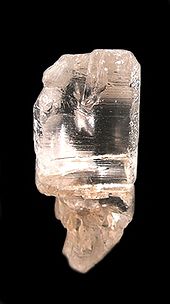Petalite
Appearance
| Petalite | ||
|---|---|---|
2V angle 82–84° measured | | |
| Melting point | 1350 °C[2] | |
| Fusibility | 5 | |
| Solubility | Insoluble | |
| References | [3][4][5][6] | |
Petalite, also known as castorite, is a
monoclinic system. Petalite occurs as colorless, pink, grey, yellow, yellow grey, to white tabular crystals and columnar masses. It occurs in lithium-bearing pegmatites with spodumene, lepidolite, and tourmaline. Petalite is an important ore of lithium, and is converted to spodumene and quartz by heating to ~500 °C and under 3 kbar of pressure in the presence of a dense hydrous alkali borosilicate fluid with a minor carbonate component.[7] Petalite (and secondary spodumene formed from it) is lower in iron than primary spodumene, making it a more useful source of lithium in, e.g., the production of glass. The colorless varieties are often used as gemstones. [citation needed
]
Discovery and occurrence

Petalite was discovered in 1800, by Brazilian naturalist and statesman
Stockholm, Sweden. The name is derived from the Greek word petalon, which means leaf, alluding to its perfect cleavage.[5][8][9]
Economic deposits of petalite are found near
Bikita, Zimbabwe
.
The first important economic application for petalite was as a raw material for the glass-ceramic cooking ware CorningWare.[citation needed] It has been used as a raw material for ceramic glazes.
References
- S2CID 235729616.
- ^ "Petalite". Digital Fire. Retrieved 23 October 2011.
- ^ Anthony, John W.; Bideaux, Richard A.; Bladh, Kenneth W.; Nichols, Monte C. (2005). "Petalite" (PDF). Handbook of Mineralogy. Mineral Data Publishing. Retrieved 14 March 2022.
- ^ Webmineral
- ^ a b Petalite, Mindat.org
- ISBN 0-471-80580-7
- ISBN 978-1-86239-144-4.
- . Journal de Physique, de Chimie, d'Histoire Naturelle, et des Arts. 51: 239.
- ^ Sowerby, James (1811). Exotic mineralogy: Or, Coloured figures of foreign minerals: As a supplement to British mineralogy.
External links
 Media related to Petalite at Wikimedia Commons
Media related to Petalite at Wikimedia Commons- . Encyclopædia Britannica. Vol. 21 (11th ed.). 1911.
